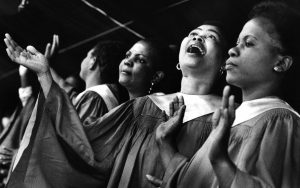
During a Sunday service at the National Pentecostal Church in Johannesburg, South Africa, a gospel choir leads the crowd in song. Photo by Dieter Telemans/Panos 4
“Gospel Music,” a specific genre of sacred American black music, reached its peak in the second half of the nineteenth century. Some of its musical predecessors include “white Pentecostal hymns, slave songs, spirituals, work songs, and evangelistic congregational songs from the seventeenth, eighteenth, and nineteenth centuries.” Gospel music has advanced by embracing musical ideas and “expressions from genres including the blues, jazz, rock, soul, classical, and country.” (Beatrice Irene 2014) Thomas A. Dorsey, dubbed “The Father of Gospel Music,” brought blues and jazz to black and white gospel songs, white evangelical hymns, and other genres even though he wasn’t the first to compose gospel songs.1
Gospel tunes from the nineteenth and twentieth centuries started to take the place of slave songs and spirituals owing to the work of composers like Charles Tindley, Lucie Campbell, and Dr. Isaac Watts2 . They “gospelized” traditional tunes by introducing African American music style, such as flattened notes, altered rhythmic pulses, and pentatonic scales. Many of Charles Tindley’s melodies were written in pentatonic scales, and, according to gospel music specialist Dr. Horace Clarence Boyer, he left leeway “for the interpolation of flatted thirds and sevenths” (Horace Clarence) in both his melodic lines and harmonic structures. Additionally, Tindley left room in his compositions for improvised language and rhythm. Thomas Dorsey advanced this by gradually merging the performance of black holy music with blues performance elements.2
Gospel singer and scholar, Horace C. Boyer, offered an explanation for how the sacred and secular gospels came to be recognized as separate categories.3 Black Americans who had never heard gospel music or had just chosen to disapprove of it for whatever reason began to support it, but not in churches. Black middle-class Americans suddenly found it highly fashionable to buy gospel CDs and watch gospel-music singers on television, even though going to concerts was still frowned upon2 . Furthermore, non-blacks held the opinion that because they view gospel singing as an “act,” it belongs in nightclubs where other entertainers also perform. 2
We can see this type of secular change in a 1969 Milwaukee Newspaper 1, when ABC-TV broadcasts the special program, The Folk Gospel Music Festival, the spectacle and emotionally “charged excitement of the best in contemporary gospel music”(Milwaukee Star 1969) will be broadcast on network television. Featuring many of the top gospel artists and figures of the time, including the inspirational Clara Walker and the Gospel Redeemers, the Staple Singers, Rev. Jesse Jackson, and Mahalla Jackson. As part of the Harlem Cultural Festival in New York City, “The Folk Gospel Music Festival” was recorded during an outdoor performance in front of 70,000 spectators.1
1 Pate, Beatrice Irene. 2014. “Southern Black Gospel Music: Qualitative Look at Quartet Sound during the Gospel ‘Boom’ Period of 1940-1960.” Order No. 1568090, Liberty University. https://www.proquest.com/dissertations-theses/southern-black-gospel-music-qualitative-look-at/docview/1609004829/se-2.
2 Boyer, Horace Clarence. “Contemporary Gospel Music.” The Black Perspective in Music 7, no. 1 (1979): 5–58. https://doi.org/10.2307/1214427.
3 Milwaukee Star (Milwaukee, Wisconsin) VIII, no. 18, September 6, 1969: Page [1]. Readex: African American Newspapers. https://infoweb.newsbank.com/apps/readex/doc?p=EANAAA&docref=image/v2%3A12A7AE31A7B3CA6B%40EANAAA-12BE206EFAC5BEF0%402440471-12BE206F06AEFFA0%400.
4 Aeonmag. “Why Repetition Can Turn Almost Anything into Music: Aeon Essays.” Aeon, aeon.co/essays/why-repetition-can-turn-almost-anything-into-music. Accessed 10 Oct. 2023.
